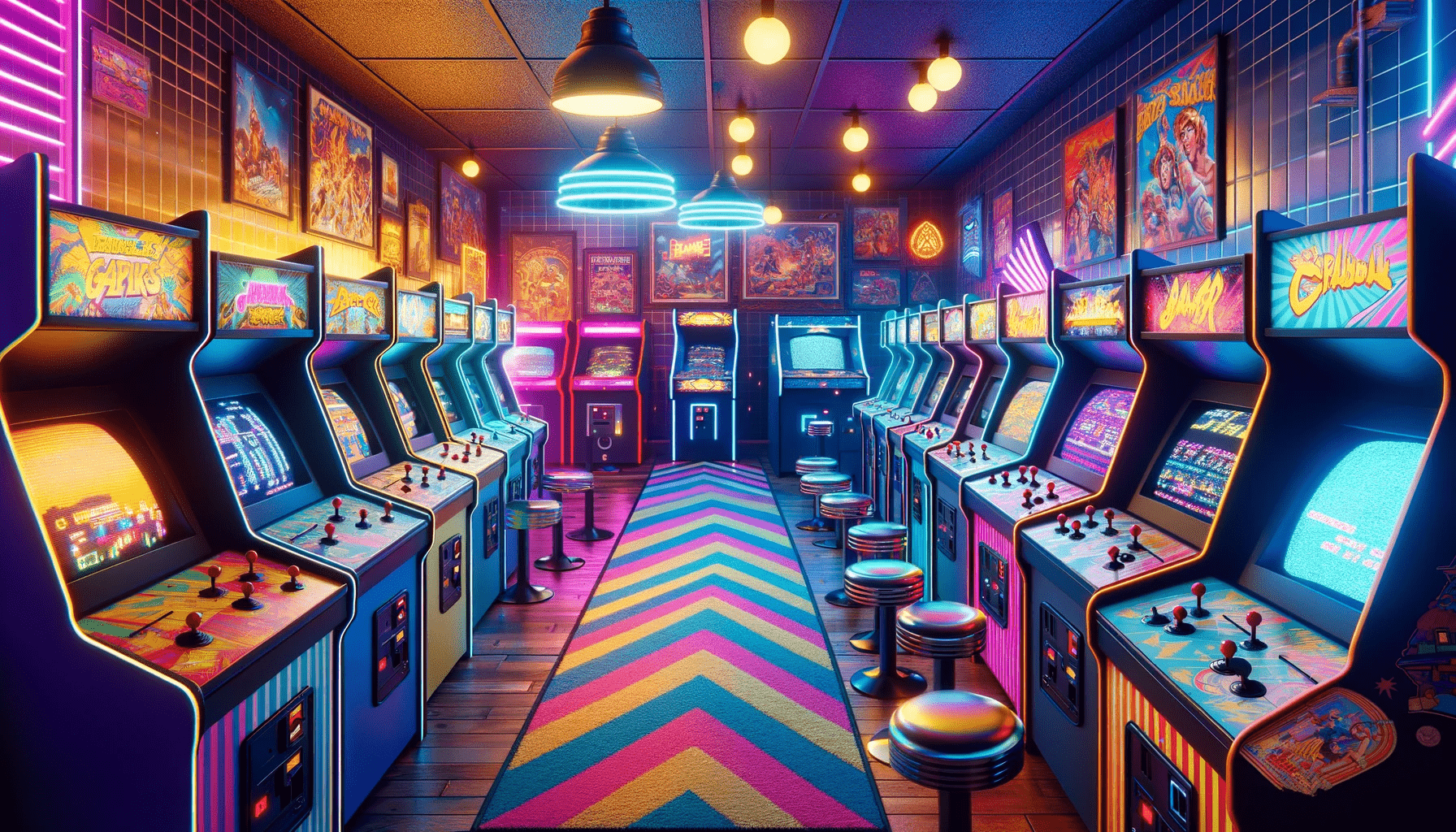Craig Retro’s Top 10 80s Arcade Games22 min read
Today we’re looking back (way back), to the best retro 80s arcade games. Say goodbye to your free time (and your allowance), ’cause these games are mighty addictive.
I was born in 1980, so I didn’t find my way into Wizard’s Castle (the arcade in the corner of our little mall), until the late 80s. By that time, I had missed Pac-Man mania and the video game industry had rebounded from the crash of the early 80s.
I was never very good at complex games, and didn’t have the patience (or stacks of quarters) required to master most games. But that sure didn’t stop me from trying.
I can still feel my eyes burning from staring at these screens for hours of entertainment. Mashing buttons like nobody’s business while never really getting better at any of them.
Each of these 10 arcade games hold a special place in my retro heart though. Alright, hold on, I’m pressing start now. And queue the nostalgia…
1) Rampage (1986)
Rampage, a classic from the golden era of arcades, unleashed its unique brand of skyscraper-smashing fun in 1986. Developed by Bally-Midway, the game was a notable departure from the typical objectives of 80s arcade games of the time.
Instead of focusing on competition or survival, Rampage was all about destruction! The designers, Jeff Nauman and Brian Colin, innovated by using the only shapes they could effectively move at the time – large rectangles. Leading to the central gameplay of demolishing buildings.
Players could control one of three monstrous characters – George, an albino gorilla; Lizzie, a giant lizard; and Ralph, a huge wolf. These creatures were the result of various bizarre transformations. Ranging from experimental vitamins to radioactive mishaps.
The goal was simple yet engaging: to wreak as much havoc as possible across cities, destroying skyscrapers, vehicles, and anything you could get your clause on.
Rampage’s gameplay included a variety of items and challenges. Players could accumulate points by destroying buildings, eating civilians, and dealing with various obstacles like helicopters and tanks. If I remember correctly you could smash into someone’s bathroom and eat a guy right off his crapper.
Health could be maintained by consuming food items scattered throughout the game. The game also featured dynamic elements like the possibility of players turning into a vulnerable human form if they took too much damage. This added a humorous touch to the gameplay as the humanoid would cover there private bits and sidestep off-screen.
The game’s success led to several ports to home consoles and computers. These included the Apple II, Atari series, Commodore 64, and more. Interestingly, the Atari Lynx version added a fourth character, Larry, a giant rat.
Rampage’s Legacy
Over the years, Rampage has been included in various game compilations. It even inspired a handheld LCD version and a mini arcade port.
Rampage’s legacy continued with several sequels and spin-offs. Expanding the universe with new characters and scenarios. Notably, in 2018, a live-action film adaptation starring Dwayne (“the Rock”) Johnson was released. Breathing new life into the franchise and even inspiring a new set of video games linked to the film.
Rampage was straightforward, fun, funny and felt like good value for the requisite 25 cents because you could smash away and not have to solve complicated puzzles, mazes, maps or bosses.
2) WWF Super Stars (1989)
By the late 80s I was a huge WWF wrestling fan and when WWF Super Stars made an appearance at our bowling alley. I made it a regular occurrence to stop by and drop a few quarters for the chance to play as some of my heroes. Being able to lay a beating on the Honky Tonk Man never seemed to get old.
WWF Super Stars, released in 1989 by Technos Japan Corp., was a groundbreaking arcade game that brought the excitement of professional wrestling to gaming arcades. It featured a selection of six iconic wrestlers: Hulk Hogan, Randy “Macho Man” Savage, The Ultimate Warrior, Hacksaw Jim Duggan, The Big Boss Man, and The Honky Tonk Man.
The game centred around tag-team wrestling. Allowing players to choose two wrestlers to form a team and compete in a series of matches in New York City and Tokyo.
The gameplay was notable for its grappling and attack system, allowing players to perform a variety of wrestling moves. These included character-specific grapple moves, standing strikes, running attacks, and more.
Unique elements like brawling outside of the ring and using objects like tables added to the game’s appeal. After winning three matches, players faced the final round against “The Million Dollar Man” Ted DiBiase and André the Giant. That tag-team was known as the “Mega Bucks” in game.
In terms of technical specifications, WWF Super Stars ran on a Motorola 68000 CPU at 10 Mhz and a Zilog Z80 CPU at 3.579545 Mhz. With sound chips including a Yamaha YM2151 and an OKI6295.
The game supported up to two players, each using an 8-way joystick and two buttons for punches and kicks. WWF Super Stars was not only a hit in arcades but also gained recognition for its technical and gameplay achievements.
WWF Super Stars Was Super Awesome
In Japan, it was listed as the third most successful table arcade unit in November 1989 by Game Machine. In North America, it topped the RePlay arcade charts as the highest-grossing software conversion kit in January 1990.
The game also included appearances from wrestling personalities like Virgil, ‘Mean’ Gene Okerlund, and Miss Elizabeth in cutscenes. Further enhancing its connection to the real-world WWF. Interestingly, the US version featured the “Winners Don’t Use Drugs” screen, a common feature in arcade games of that era.
WWF Super Stars laid the foundation for many future wrestling video games, with its blend of authentic wrestling action and engaging arcade gameplay setting a high standard for the genre.
3) Spy Hunter (1983)
Spy Hunter, released in 1983 by Bally Midway, is a classic in the realm of arcade games. Known for its innovative blend of driving and shooting gameplay.
The game was inspired by James Bond films, as evident in its spy-themed action. Although it originally intended to use the James Bond theme music but eventually settled on Henry Mancini’s theme to “Peter Gunn” due to licensing issues.
Spy Hunter was an older title at our arcade. It was usually available to play without having to wait in line because most of its novelty had worn off. But the music was still the coolest. The gameplay itself was fairly straightforward and fun too.
In Spy Hunter, players control a high-tech car equipped with various weapons. Tasked with eliminating enemy vehicles while protecting civilian cars.
The game’s appeal was further enhanced by its unique features, such as the ability to transform the car into a speedboat for river sequences and various weapon upgrades provided by a weapons van.
Technically, the game was powered by a Zilog Z80 CPU, with a vertical screen orientation and a resolution of 480 x 480 pixels. It featured distinct control mechanisms, including a steering wheel with a gear shift, pedal, and multiple buttons for different weapons like machine guns, smoke screens, and oil slicks.
Spy Hunter’s Legacy
The game’s popularity soared, topping the RePlay arcade cabinet charts for several months in 1984. It was also listed as one of America’s top-grossing arcade games of that year.
Its success led to a sequel, Spy Hunter II, and influenced many later video games, and even inspired a pinball table.
Spy Hunter also made its mark in pop culture, with references in television shows and its inclusion in video game compilations like “Midway’s Greatest Arcade Hits” and “Midway Arcade Treasures.”
A film adaptation was even planned, featuring Dwayne “The Rock” Johnson. Unfortunately it never panned out due to several production challenges and changes in direction.
Despite its age, Spy Hunter remains a beloved classic 80s arcade game. Remembered for its challenging gameplay, memorable music, and significant impact on the arcade game industry.
4) 10-Yard Fight (1983)
10-Yard Fight was another game that often sat collecting dust in the corner, but that I loved for its simplicity. And because there weren’t many people around it, so if I sucked at it (and I did), no one would know.
10-Yard Fight, developed and published by Irem in 1983, holds a significant place in the history of arcade football games. It was later published overseas by Taito in the Americas and by Electrocoin in Europe.
The game was a pioneer in introducing a more “realistic” representation of football players in arcade games. Moving away from the basic blips or “Xs & Os” that were commonly used to depict players in earlier football games. It’s hilarious to look back at what was considered “realistic” back in the day.
The gameplay of 10-Yard Fight was unique for its era. It featured a top-down perspective with vertical scrolling, and the player did not select plays for either offence or defence.
The offensive gameplay was straightforward – the player could run with the quarterback, pass the ball to a running back, or throw it to a long-distance receiver. On defence, the player controlled one of two players while the computer handled the rest. The game also allowed for punting and field goal attempts.
10-Yard Fight had five levels of difficulty, ranging from high school to the Super Bowl. Advancing through the levels required winning both halves of an “accelerated real time” 30-minute half at the current level. This progression system resembled a career mode, adding depth to the arcade experience.
10-Yard Fight, Fights On
The game achieved notable success in Japan, topping the new table arcade cabinet chart in January 1984 and again in March 1984. It was praised for bringing football games out of the Atari era and setting a precedent for future football games. Even though it was later viewed as less realistic compared to later games like Tecmo Bowl.
The arcade version of 10-Yard Fight was eventually ported to the Famicom/NES by Irem, first in Japan and later in North America, and Europe by Nintendo. The NES version of the game introduced both offensive and defensive gameplay, as well as a two-player mode. Expanding on the arcade version’s features.
The game’s legacy was revived with a port for the Nintendo Switch released by HAMSTER in May 2018, as part of their Arcade Archives series. Earning its rightful place amongst some of the more notable 80s arcade games.
Overall, 10-Yard Fight is remembered as a groundbreaking game that laid the foundation for more advanced football video games. Influencing the development of popular titles like “Tecmo Bowl” and “Madden”.
5) Bubble Bobble (1986)
Bubble Bobble was developed by Taito, and it quickly became a hit in arcades due to its charming design and engaging gameplay.
The game featured two dragons, Bub and Bob, who blew bubbles to trap enemies. Once trapped, the enemies could be popped for points. This simple yet innovative mechanic set Bubble Bobble apart from other 80s arcade games of the era.
The game was known for its cooperative two-player mode, where players could team up to navigate through the levels. Each level was a single screen filled with platforms, enemies, and various power-ups. The objective was to clear the screen of enemies to progress to the next level, with a total of 100 levels to complete.
Bubble Bobble also stood out for its catchy and memorable music, which added to the game’s overall appeal. This game had lots of little secrets waiting to be unlocked by bubble masters.
The game’s success led to several ports to home consoles and computers. It also spawned numerous sequels and spin-offs, cementing its status as a classic in the video game industry.
6) Double Dragon II: The Revenge (1988)
Double Dragon II: The Revenge was released by Technos Japan Corp in 1988. A noteworthy sequel in the beat ’em up genre that built upon the success of the OG Double Dragon.
The game’s plot revolves around the brothers Billy and Jimmy Lee seeking vengeance for the murder of their friend, Marian, by the Black Warriors gang.
This sequel retained many attacks and combos from the original game, while also introducing new techniques like the Cyclone Kick. The cyclone kick had sweet sound effects that emphasized its real ultimate power.
The game featured a unique two-way attacking system and presented new traps and transition sequences between stages, such as entering the next level via a lift.
Most of the enemy characters from the original game returned. Some with visual updates, and the stage bosses were entirely new.
Double Dragon II was a perfect blend of late 80s weirdness as it combined street fighting with Japanese culture and cool dudes rocking rad shades.
The controls were fairly easy, but beating the waves of foes and the gigantic level bosses was difficult. It was another good game to play with a bud, or better yet with an older, wiser, gamer that took pity on watching you struggle and offered to drop in and help you out.
In terms of technical aspects, the game operated on a HD6309 CPU at 3.579545 Mhz and a Zilog Z80 CPU at 4 Mhz, with Yamaha YM2151 and OKI6295 sound chips. The control setup featured an 8-way joystick and three buttons for punching, kicking, and jumping.
Seeing Double – The Game Was an Early Example of A Sequel Outdoing its Original
Double Dragon II was ported to various platforms, including the NES, ZX Spectrum, Commodore 64, IBM PC compatibles, Amiga, Atari ST, and more. Each port had its unique variations and adaptations from the arcade version. For instance, the NES version, developed by Technōs themselves, was quite distinct from the arcade game. The Mega Drive version was a closer port of the arcade game but had some level design changes and compatibility issues with certain controllers.
The game received positive reviews and was particularly successful in Japan. Where it was listed as the seventh most-successful table arcade unit in April 1989. In the United Kingdom, it was among the top-selling Atari ST games in early 1990. Double Dragon II has been re-released multiple times, including a 2013 compilation titled Double Dragon Trilogy on various platforms like iOS, Android, and Steam.
Double Dragon II is remembered for its enhanced gameplay, memorable characters, and its role in advancing the beat ’em up genre. Its legacy includes various sequels and adaptations, maintaining its status as a classic in the video game world.
7) Teenage Mutant Ninja Turtles (1989)
Teenage Mutant Ninja Turtles, the arcade game released by Konami in 1989, became a significant hit, especially in North America. It captured the essence of the popular TMNT franchise and translated it into an engaging arcade experience.
The game featured an eight-way joystick for movement, a jump button, and an attack button. Allowing players to use the Turtles’ weapons and execute special moves. Most enemies were colour-coded Foot Soldiers, each with unique attack patterns and weapons.
Ninja Turtles was an essential arcade experience for most kids my age and usually had a long line up. I remember it being too hard for me, but still wanting to play so that I could be Michelangelo – my favourite turtle. Even if only for a few seconds before I died (onscreen).
The game was notable for its special moves, such as throwing Foot soldiers and performing unique attacks like Raphael’s rolling kick. The Turtles could also spring off walls and slam enemies into solid objects for quicker defeats. The game’s bosses included recognizable characters from the series, such as Rocksteady, Bebop, and Shredder.
Due to its popularity, the arcade game was ported to the NES in 1990. But with some changes and additions, including new levels and bosses.
The game was a commercial blockbuster, becoming Konami’s highest-grossing arcade game and topping arcade charts throughout 1990. By early April 1990, over 20,000 arcade cabinets had been sold internationally. Sales were further boosted by the release of the TMNT film.
The game’s success marked a high point in the TMNT franchise’s popularity during this period. Contrasting this 89 release with 80s arcade games from a few years earlier, it’s graphics were leaps and bounds better.
8) Commando (1985)
Commando, developed by Capcom and released in 1985, stands out as a significant entry in the early run-and-gun shooter genre. Designed by Tokuro Fujiwara, who was concurrently working on Ghosts ‘n Goblins, Commando enjoyed both critical and commercial success. Becoming one of the highest-grossing arcade games of 1985 and one of the best-selling home video games of 1986.
Its success led to a spate of similar games, effectively spawning a new sub-genre. Commando was my favourite game in that style, it was fun and re-playable.
The game featured eight unique levels in the arcade version. The NES version adaptied these levels into sixteen stages with increasing difficulty. The player controls a soldier who battles through enemy lines, demonstrating the game’s fast-paced action and engaging gameplay.
Commando was ported to several platforms, including the NES, Atari 2600, Commodore 64 and Amstrad CPC. The Commodore 64 port’s theme, famously composed by Rob Hubbard, is particularly noteworthy for its complexity and the speed of its creation.
In Japan, Commando was the most popular arcade game in June 1985. By November of the same year, it had topped the American RePlay chart for upright cabinet-based 80s arcade games. It also saw significant success in the UK, leading to substantial orders and becoming a major hit across Europe. By June 1985, more than 15,000 arcade units had been sold.
The game’s home computer ports topped UK sales charts in late 1985 and early 1986. Becoming one of the best-selling games of 1986 in the UK. The NES version, released in 1986, achieved global sales of 1.14 million copies.
Commando Stays in Command of Its Legacy
The game’s influence extended well into the future. Being recognized in various accolades and later re-releases on platforms like the Virtual Console and mobile phones.
Commando is remembered not just for its commercial success but also for its influence on the development of the shooter genre and its impact on the gaming culture of the 1980s.
9) Cyberball (1988)
Cyberball, released by Atari Games in 1988, is an innovative arcade game that combines elements of American football with a futuristic theme. The game features robotic avatars, each with varying speeds, sizes, and skill sets.
One of the unique aspects of Cyberball is its gameplay mechanics, which diverge from traditional football. The game uses an explosive ball that progresses through different status levels – from “cool” to “warm,” “hot,” and finally “critical” – as it is used.
To reset the ball back to “cool,” players must cross the 50-yard line or change possession, either through a touchdown, interception, or fumble. If a robot is holding a critical ball when tackled, it explodes along with the ball. The robots also have a finite level of durability, degrading and eventually exploding after sustaining multiple hits.
Cyberball was particularly noted for its gameplay in multiplayer mode. Supporting single-player, two-player cooperative, two-player head-to-head, or four-player head-to-head configurations. This flexibility allowed for varied and strategic gameplay, significantly enhancing its popularity and leading to numerous tournaments across the United States.
The game’s offensive plays began with identical formations. Enabling human players to disguise their intentions before breaking for their assigned pass locations. This level of strategic depth was a key factor in the game’s appeal.
Cyberball combined 2 of my favourite things: football and sci-fi, and I played it a lot.
Steel Blue 32, Steel Blue 32, Ready, Set, Hut!
Following its success, Atari Games released sequels and updates. Including Tournament Cyberball 2072 in 1989, which introduced new gameplay modes, additional plays, and enhancements like the “powerback.”
The game was also ported to several home consoles and computers, including the NES, Sega Genesis, Atari ST, Amiga, Commodore 64, Amstrad CPC, and ZX Spectrum. Each port adapted the game to the capabilities and limitations of its respective platform.
Cyberball received positive reviews for its arcade version, praised for its fast-paced, hard-hitting action. However, the NES version was noted for not being able to replicate the detailed graphics of the arcade version. Making it feel more primitive compared to the futuristic vision of the original game. The Sega Genesis version was commended for being a decent conversion from the arcade version, particularly for its graphics.
Overall, Cyberball is remembered as a highly influential futuristic sports game that brought a fresh and exciting twist to the sports game genre.
10) Gauntlet (1985)
“Gauntlet,” developed and published by Atari Games, was a pioneering dungeon crawler that introduced several innovative features to the arcade genre. It was one of the first games to offer cooperative multiplayer gameplaY. Allowing up to four players to navigate through dungeons simultaneously.
Each player could choose from four characters: Thor the Warrior, Merlin the Wizard, Thyra the Valkyrie, or Questor the Elf. Each character had their own unique abilities and attributes.
The game stood out for its top-down perspective and maze-like levels filled with various enemies, traps, and treasures. The players’ objective was to fight through the hordes of enemies, which included ghosts, grunts, demons, and sorcerers, and find the exit to advance to the next level. The game’s levels were not linear, offering multiple paths and secret rooms, adding to its replay value.
One of the distinctive features of “Gauntlet” was its health system. Players’ health points continuously ticked down, which could be replenished by collecting food found in the levels.
Additionally, the game featured voice-overs, with memorable phrases like “Wizard needs food badly!” becoming a hallmark of the game.
“Gauntlet” was highly successful in terms of 80s arcade games, and led to numerous sequels and ports to home systems. Its blend of action, strategy, and cooperative gameplay made it a classic. Significantly influencing subsequent dungeon crawler and multiplayer games.
Gauntlet was more of my friend Jason’s favourite game. However, it made my list because a lot of my trips to Wizards castle were made with Jason. He was much better than me at most games, including gauntlet. But I have fond memories of playing it together. Sadly Jason and I kind of grew apart over the years, but I have a lot of awesome memories of playing 80 arcade games together.
The Legacy of Retro 80s Arcade Games
Reflecting on these iconic games is like opening a time capsule filled with joy, challenge, and a touch of pixelated magic.
Each title, from the monster-mashing fun of Rampage, to the cooperative dungeon delving in Gauntlet, represents a unique aspect of the golden age of 80s arcade games.
These games were often communal experiences. Shared in bustling arcades and bowling alleys resonating with the sounds of laughter, and the clinking of quarters.
As we journey through the world of retro 80s arcade games, it’s not just about remembering the games, but also reliving the moments.
Whether it was at the Wizard’s Castle or in the arcade at your local shopping mall, these games were the backdrop to countless memories and friendships. For more information about this era, read our article: The Evolution of Video Games: From 80s Arcades to Modern eSports.
Now, I turn to you, fellow gamers and retro rememberers. What are your favourite 80s arcade games from the?
Do you have memories of hanging out in arcades with a pocket full of quarters too?
Share your top picks, and let’s keep the conversation going about 80s arcade games’ unique place in video game history.
Thanks for stopping by.
Have a rad rest of your day!




